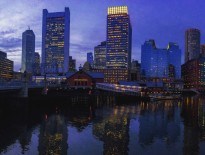All the hand-wringing over whether Millennium Partners proposed $1 billion tower will cast a few shadows over Boston Common from its Financial District perch a quarter mile away is just a classic NIMBY tempest in a teapot.
But the outcry has overshadowed, no pun intended, a pair of far more important and related questions: Can the Financial District be saved and is Millennium’s proposed 55-story condominium and office tower the right way to go about it?
The Financial District, once the pride of Boston’s business community, is fast slipping into a second-class backwater, put to shame by the far more vibrant Back Bay and increasingly eclipsed by the booming Seaport District.
In time, the development of the Seaport District may prove to be the best thing for Boston since the Back Bay was created in the late 1800s. But right now, the Seaport is proving to be a disaster for Boston’s traditional and now struggling business district, with companies bailing out of the Financial District at an alarming rate for new digs on the waterfront.
The amount of empty office space in the Financial District climbed by a staggering 850,000 square feet in 2016, enough to fill a large tower, according to Colliers International. It’s the kind of bloodletting you’d expect during a recession, not during a time when the Boston area as a whole is booming.
Even more disturbing, the amount of empty high-rise space in the Financial District – above the 20th floor – “has never been higher,” Colliers recently noted, pointing to a whopping 19.7 percent vacancy rate. And this is for the district’s prime space.
The Financial District’s losses have been the Seaport’s gains, with the fast-expanding waterfront district filling a substantial block of 400,000 square feet of office space in 2016, often with help of longtime business district stalwarts like the law firm Goodwin, which bailed on its State Street offices.
The decades-long city planning process that resulted in the jumbled rollout of the Seaport, with its highway-sized boulevards and mix of mostly unimaginative high-rises amid a sea of construction sites, has taken its fair share of heat.
But amid all the fretting over waterfront access and building heights, I can recall few discussions – and no real debate – on what opening up this new tract of development land would do what had been Boston’s corporate power center, just a literal hop and skip away on the other side of the Fort Point Channel.
After all, if you build a whole bunch of new office high-rises in a new waterfront neighborhood next door to your aging central business district, it doesn’t take a rocket scientist to figure out what would happen next, especially if the new neighborhood is not radically or fundamentally different from the old one. The Seaport in some ways is a new and improved Financial District, with a waterfront perch and a better mix of “uses,” but it’s hardly a completely new animal.
Now the ramifications of City Hall’s years-long drive to build out the Seaport at all costs can be seen in a Financial District that is steadily being drained of its most prestigious corporate residents.
The question, is can anything be done to reverse the fortunes of the Financial District?
Tech Tenants Aren’t Enough
The booming tech market has provided a lifeline of sorts, with a range of companies from established firms to startups decamping from more expensive space in Cambridge and its environs to the more budget-friendly lower floors of the Financial District’s tall timber, almost all of it built in the 1960s, ’70s and ’80s.
But the tech market is not necessarily a cure-all, especially given the fact that the industry’s giants aren’t leaving Kendall Square anytime this century. And tech is a boom and bust sector, with a wave of flashy startups renting all sorts of space in the Financial District during the dot-com bubble of the late ’90s, only to leave large blocks empty when the bust came.
Nor will cost-conscious startups solve the problem of all those empty offices in the top floors of the Financial District’s towers.
Enter Millennium Partners, which after winning a bidding war to redevelop a crumbling city garage in the heart of the Financial District, is emerging as a potential savior, or at least a potential kick-starter, for the flagging neighborhood.
Having blown away the competition with a hefty $153 million bank transfer to City Hall, Millennium is closing in on city approval to replace the decrepit Winthrop Square garage with a 55-story condo and office tower featuring a three-story “Great Hall” at the base.
Millennium comes to the project having previously turned around two failing Boston neighborhoods, putting the stake through the heart of the old Combat Zone in the last 1990s with the Ritz-Carlton Towers and then resurrecting beleaguered Downtown Crossing.
Millennium’s plan for Winthrop Square is a vast improvement over the late Mayor Menino’s proposal a decade ago to replace the old city garage with a 1,000-foot office skyscraper, which became known as “Tommy’s Tower.”
The massive tower, which would have featured a million square feet of office space, would have detonated over the struggling Financial District like a neutron bomb, sucking tenants out of all the surrounding towers.
The multimillion-dollar condos Millennium plans to build could certainly provide a badly needed infusion of life to the Financial District, which is all but dead after 5 p.m.
Yet by adding newer and much more attractive office space to a business district that is awash in empty corporate suites, the new Millennium tower, like Menino’s proposal before it, could wind up vacuuming up badly needed tenants from other high-rises, albeit on a much smaller scale.
And the Financial District is likely to prove much harder to turn around than the old Combat Zone or Downtown Crossing, which had strip clubs ripe for demolition and old buildings prime for renovation.
If a State Street tower goes half empty, it’s not likely anyone is going to tear it down to make way for something else.
I wouldn’t ever bet against Millennium. But turning around Boston’s Financial District is going to be no easy feat.




 |
| 




